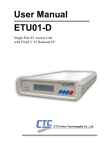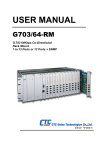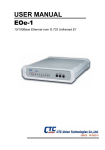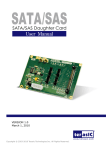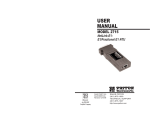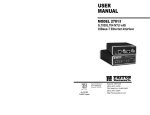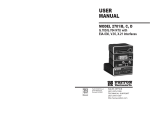Download CTC Union ETU01C Specifications
Transcript
ETU01-Plus ETU01U-Plus Single V.35 Port G.703 E1 Access Unit CTC Union Technologies Co., Ltd. Far Eastern Vienna Technology Center 8F, No. 60 Zhouzi Street Neihu District, Taipei, 114 Taiwan ETU01-Plus (ETU01U-Plus) E1 Access Unit, Installation and Operation Manual Version 1.0 July 1, 2009 (Official Release) Version 1.1 August 21, 2009 Update Version 1.11 December 2, 2009 correction Version 1.2 March 25, 2010 Update This manual supports the following models: ETU01-Plus-AC universal AC model, Fixed V.35 ETU01-Plus-DC universal (18~75V) DC model, Fixed V.35 ETU01U-Plus-AC unframed E1, universal AC model, Fixed V.35 ETU01U-Plus-DC unframed E1, universal (18~75V) DC model, Fixed V.35 Table of Contents CHAPTER 1 INTRODUCTION.............................................................................7 1.0 WELCOME ..........................................................................................................7 1.1 PRODUCT DESCRIPTION .....................................................................................7 1.2 TECHNICAL SPECIFICATIONS ..............................................................................7 1.3 E1 SIGNAL STRUCTURE.....................................................................................10 1.4 ETU01-PLUS CAPABILITIES .............................................................................11 1.5 SYSTEM TIMING CONSIDERATIONS ..................................................................11 1.6 FUNCTIONAL DESCRIPTION ..............................................................................14 1.7 LOOPBACK FEATURE........................................................................................15 1.8 TYPICAL SYSTEM APPLICATIONS .....................................................................15 CHAPTER 2. INSTALLATION ...........................................................................17 2.1 GENERAL .........................................................................................................17 2.2 SITE PREPARATION ..........................................................................................17 2.3 MECHANICAL ASSEMBLY.................................................................................17 2.4 ELECTRICAL INSTALLATION .............................................................................17 2.4.1 Power connection .....................................................................................17 2.4.2 Rear panel connectors..............................................................................17 2.5 DIP SWITCHES .................................................................................................18 2.5.1 Caution .....................................................................................................18 2.5.2 Procedure .................................................................................................18 CHAPTER 3. OPERATION .................................................................................21 3.1 GENERAL .........................................................................................................21 3.2 CONTROLS AND INDICATORS............................................................................21 3.3 OPERATING PROCEDURE ..................................................................................23 3.3.1 Visual Indicators ......................................................................................23 3.3.2 Configuration Settings..............................................................................23 3.4 QUICK START GUIDE........................................................................................24 CHAPTER 4. TEST & DIAGNOSTICS ..............................................................25 4.1 GENERAL .........................................................................................................25 4.2 LOOP BACK TESTS ...........................................................................................25 4.3 BIT ERROR RATE TESTER .................................................................................25 4.4 LOCAL ANALOG LOOP BACK ...........................................................................26 4.5 LOCAL DIGITAL LOOP BACK ............................................................................26 4.6 REMOTE DIGITAL LOOP BACK .........................................................................27 4.7 QUICK E1 SELF-TEST .......................................................................................27 i Table of Contents APPENDIX..............................................................................................................28 A.1 ETU01-PLUS ALL DIP SWITCH OVERVIEW ....................................................28 A.2 DIP SW1 TIME SLOT 0 TO 7 SETTING .............................................................28 A.3 DIP SW2 TIME SLOT 8 TO 15 SETTING ...........................................................29 A.4 DIP SW3 TIME SLOT 16 TO 23 SETTING .........................................................30 A.5 DIP SW4 TIME SLOT 24 TO 31 SETTING .........................................................31 A.6 DIP SW5 PARAMETER GROUP 1 SETTING .......................................................32 A.7 DIP SW6 PARAMETER GROUP 2 SETTING .......................................................33 A.8 CLOCK MODE DETAILS ...................................................................................34 B.1 ETU01U-PLUS ALL DIP SWITCH OVERVIEW ..................................................34 B.2 DIP SW5 PARAMETER GROUP 1 SETTING .......................................................34 B.3 DIP SW6 PARAMETER GROUP 2 SETTING .......................................................36 B.5 CLOCK MODE DETAILS ....................................................................................37 C.1 E1 LINE CONNECTORS .....................................................................................38 C.1.1 BNC Connectors ......................................................................................38 C.1.2 RJ-45 Connector ......................................................................................38 C.2 V.35 DATA CONNECTOR..................................................................................39 ii Chapter 1. Introduction Chapter 1 Introduction 1.0 Welcome Thank you for selecting the ETU01-Plus for your E1 service termination. We hope you find this device in perfect working order and that it provides many years of reliable service. 1.1 Product Description The ETU01-Plus is a single V.35 serial port access unit for E1 or Fractional E1 service. The ETU01U-Plus is a single V.35 serial port access unit for Unframed E1 only. The ETU01-Plus AC model has a universal, auto-switching power supply (90~250VAC) while the DC model's internal regulator module accepts DC voltages from 18 to 75 volts. 1.2 Technical Specifications E1 link Framing Bit Rate Line Code Line Impedance Relative Receive Level "Pulse" Amplitude "Zero" Amplitude Transmit Frequency Tracking Internal Timing Loopback Timing External Timing Jitter Performance Complies With Interface Connectors -Unframed (ETU01U-Plus only Unframed) -CCS (PCM31)/CAS (PCM30) -CRC4 ON/OFF 2.048 Mbps -AMI -HDB3 -75 ohms -120 ohms 0 to -43dB -Nominal 2.37V±10% for 75 ohms -Nominal 3.00V±10% for 120 ohms ±0.1V ±30 ppm ±50 ppm ±100 ppm According to ITU-T G.823 ITU-T G.703, G.704, G.706 and G.732 -BNC (unbalanced) -RJ-45 (balanced) per USOC RJ-48C 7 Chapter 1. Introduction User Data Channel Fixed Interface Interface Connectors V.35 Interface Line Code Data Rate Clock Modes Clock Mode 0 (DCE1) Clock Mode 1 (DCE2) Clock Mode 2 (DTE1) Clock Mode 3 (DTE2) Clock Mode 4 (DTE3) Control Signals Time slot allocation -V.35 34 pin, M-Block Female NRZ N×56kbps or N×64kbps where N equal 1 to 31 in CCS and N equal 1 to 30 in CAS 2.048Mbps Unframed Receive and transmit clock (recovered) to the synchronous DTE Receive and transmit clock (internal oscillator) to the synchronous DTE Receive clock to the synchronous, and transmit clock from the synchronous device Receive and transmit clock from the synchronous DCE (from ETC and ERC pin ) Receive and transmit clock from the synchronous DCE (all from ETC pin). -CTS constantly ON -DSR constantly ON, except during test loops -DCD constantly ON, except during signal loss User defined (N.A. for Unframed) 8 Chapter 1. Introduction Diagnostics Test Switches/Diagnostics LED indicators PWR TD RD RTS DCD Tx CLK Loss Signal Loss Sync Loss Alarm Error Test Green Green Green Green Green Red Red Red Red Red Red Physical Height: Width: Depth: Weight: Power supply Voltage Frequency Power consumption Environment Temperature Humidity -Digital local loop back -Analog local loop back -Digital remote loop back -Test pattern / generator Power Transmit data Receive data Request to sent Data carrier detect Transmit clock loss E1 line signal loss E1 line sync loss E1 line alarm, include: BPV error / CRC4 error / Frame slip / All ones(AIS) / Remote alarm Bit errors during integral BERT Loop back and pattern test enabled 45 mm (1 3/4") 195 mm (7 5/8") 155 mm (6 1/8") 0.5 kg (1 lb 2 oz) 90~250VAC (universal AC model) 18~75VDC (universal DC model) 47 to 63 Hz for AC 10 Watts -10°~60°C / 15°~140°F 0 to 95% non-condensing 9 Chapter 1. Introduction 1.3 E1 signal structure The E1 line operates at a nominal rate of 2.048Mbps. The data transferred over the E1 line is organized into frames, with each E1 frame containing 256 bits. The 256 bits consist of 32 time slots of eight bits each, which carry the data payload. E1 transmission utilizes two main types of framing: Frame Alignment Signal (FAS) and Multi-Frame Alignment Signal (MFAS). Framing is necessary in order for equipment receiving the E1 signal to be able to identify and extract the individual channels. PCM-30 (CAS) transmission system use MFAS framing along with the FAS framing. PCM-31 (CCS) transmission system use only FAS framing. Frame Alignment Signal (FAS) The 2.048 Mbps frame consists of 32 individual time slots (numbered 0-31). As described previously, each time slot consists of an individual 64Kbps channel of data. In the FAS format, time slot 0 of every other frame is reserved for the frame alignment signal pattern. Alternate frames contain the FAS Distant Alarm indication bit and others bits reserved for national and international use. Multi-Frame Alignment Signal (MFAS) MFAS framing uses Channel Associated Signaling (CAS) to transmit A/B/C/D bit signaling information for each of 30 channels. This method uses the 32 time slot frame format with time slot 0 for the FAS and time slot 16 for the Multi-Frame Alignment Signal and the Channel Associated Signaling. E1 line signal The basic E1 line signal is coded using the Alternate Mark Inversion (AMI) or HDB3 rule. In the AMI format, "ones" are alternately transmitted as positive and negative pulse, whereas "zeros" are transmitted as a zero voltage level. AMI is not used in most 2.048Mbps transmissions because synchronization loss occurs during long strings of data zeros." In the HDB3 format, a string of four consecutive zeros is replaced with a substitute string of pulses containing an intentional bipolar violation. The HDB3 code substitutions provide high pulse density so that the receiving equipment is able to maintain synchronization with the received signal. 10 Chapter 1. Introduction 1.4 ETU01-Plus Capabilities E1 link line coding The ETU01-Plus and ETU01U-Plus support two E1 line codes: AMI coding. HDB3 coding. E1 framing formats The ETU01-Plus supports three formats: Unframed format. FAS (CCS, PCM-31) format. MFAS (CAS, PCM-30) format. The ETU01U-Plus supports only unframed format. User data channel rates The ETU01-Plus supports user data channel rates which are a multiple of 56 or 64kbps. For maximum flexibility, the ETU01-Plus supports data rates up to 2.048Mbps. The ETU01-Plus supports flexible time slot assignment, allowing the user to freely specify the selection of time slots. The ETU01U-Plus supports unframed operation with a data rate of 2.048Mbps only. 1.5 System Timing Considerations The ETU01-Plus has the flexibility to meet the timing requirements of various system configurations. The timing mode for the E1 link and the user data channel are selected by the setting of DIP switches. E1 link timing The ETU01-Plus E1 link receive path always operates on the receive clock. The ETU01-Plus recovers the receive clock from the received E1 link data signal. The source of the ETU01-Plus E1 link transmit clock can be selected by the user. The following E1 link transmit timing modes are available. Recovery (loop back) timing: The ETU01-Plus E1 link transmit clock is locked to the recovered receive clock. This is usually the timing mode selected for network operation. Internal timing: The ETU01-Plus E1 link transmit clock is derived from the internal clock oscillator. This timing mode is necessary in point-to-point applications over leased line. In this case, one ETU01-Plus must use the internal oscillator, and the others must operate from the recovered clock. External timing: The ETU01-Plus E1 link transmit clock is locked to the clock signal provided by the user DCE connected to the data channel. When the data channel is used as the clock source, the data channel must use clock timing mode 3 (DTE2) or 4 (DTE3). 11 Chapter 1. Introduction The ETU01-Plus can select from one of five clocking mode settings. Clock mode 0 (DCE 1): The ETU01-Plus data channel operates as a DCE and provides both transmit and receive clocks (recovered timing) to the data terminal equipment connected to the user channel. The clocks are locked to the recovered E1 timing. Clock Mode 0: Recovery TC DTE Connected Equipt. RC DCE Data Port TX E1 E1 transceiver RX Figure 1.1 Recovery timing Clock mode 1 (DCE 2): The ETU01-Plus data channel operates as a DCE and provides both transmit and receive clocks (internal oscillator timing) to the data terminal equipment connected to the user channel. The clocks are locked to the oscillator timing. DTE Connected Equipt. TC RC Clock Mode 1: Internal DCE Data Port TX E1 OSC E1 transceiver RX Figure 1.2 Internal Timing The internal oscillator provides the clocking source for both the user data receive timing out the RC and TC pins and the E1 transmit timing. 12 Chapter 1. Introduction Clock mode 2 (DTE 1): In the transparent clocking mode, the ETU01-Plus data channel supplies the receive clock to the synchronous DCE, and accepts a transmit clock from the DCE (from the ETC pin). The DCE must transmit data at the rate of the clock signal supplied by the ETU01-Plus. Clock Mode 2: Transparent DCE Connected Equipt. ETC RC Crossover Cable TX DCE Data Port E1 E1 transceiver RX Figure 1.3 Transparent Timing The E1 receive clock provides the clocking source for the user data receive timing out the RC pin. The user data transmit timing is input from the ETC pin and provides the clock for the E1 transmit link. Clock mode 3 (DTE 2): The ETU01-Plus data channel is physically wired as DCE. However, the ETU01Plus may operate as a DTE when connected to other DCE equipment by using a cross-over data cable and by setting the clock mode to the DTE2 setting. NOTE: The X.21 data channel cannot be operated in clock timing mode 3 (DTE2). Clock Mode 3: External DCE Connected Equipt. ETC ERC Crossover Cable TX DCE Data Port E1 E1 transceiver RX Figure 1.4 External Timing The clock input from the ERC pin provides clocking source for the receive timing, while clock input from the ETC pin provides the clocking source for the user data transmit timing and the E1 transmit link. 13 Chapter 1. Introduction Clock mode 4 (DTE 3): The ETU01-Plus data channel is physically wired as DCE (classed as communication equipment). However, the ETU01-Plus may operate as a DTE when connected to other DCE equipment by using a cross-over data cable and by setting the clock mode to the DTE3 setting. The ETU01-Plus data channel then operates as a DTE and accepts both transmit clock and receive clock (both from the ETC pin) from the user equipment. Clock Mode 4: External DCE Connected Equipt. ETC TX DCE Data Port Crossover Cable E1 E1 transceiver RX Figure 1.5 External Timing The clock input from the ETC pin provides both clocking sources for the receive timing and for the user data transmit timing as well as clock for the E1 transmit link. 1.6 Functional Description The ETU01-Plus is a single port access unit for E1 or Fractional E1 service. The ETU01U-Plus is a single port access unit for Unframed E1 only. The ETU01-Plus AC model has a universal, auto-switching power supply (90~250VAC) while the DC model's internal regulator module accepts DC voltages from 18 to 75 volts. The ETU01-Plus data channel supports user-selectable transmission rates, which are integer multiples of 56 or 64kbps, up to a maximum 2.048Mbps, for a line attenuation of up to 43 dB on twisted pair or coax cable. This provides an approximate operating range up to 2km (22AWG). (The ETU01U-Plus data interface supports a full 2.048Mbps unframed rate ONLY.) The ETU01-Plus packs the data channel into E1 link time slots in user-selected time slots. The unused time slots can insert IDLE code (In frame mode) or insert the receive side time slots data (In cascade mode). (The ETU01U-Plus only supports unframed mode and transparently uses the entire E1 bandwidth.) The ETU01-Plus fully meets all of the E1 specifications including ITU-T G.703, G.704, G.706, G.732, and G.823. 14 Chapter 1. Introduction 1.7 Loopback Feature The ETU01-Plus features V.54 diagnostic capabilities for performing local loop back and remote digital loop back. The operator at either end of the line may test both the ETU01-Plus and the line in the digital loop back mode. The loop back is controlled by either a manual switch or by the V.35 DTE interface. A front panel switch generates an internal 511 bit pseudo random test pattern, according to ITU-T, for direct end-to-end integrity testing. The Error indicator flashes for each bit error detected. 1.8 Typical System Applications The fractional E1 data service is based on the assumption that the user data rate is a fraction of the available E1 bandwidth, in multiples of 56K or 64K. In a typical application (Figure 1.6), the ETU01-Plus is used to connect the synchronous user DTEs over an E1 line. Figure 1.6 E1 Point-to-Point Application When connected in this fashion, one ETU01-Plus must have its clock set to Internal Oscillator to provide a reference clock for the E1. The unit on the opposite side of the E1 link will set its clocking to E1 Recovery. Line coding, Framing, and Timeslot assignment must match on both sides. The ETU01-Plus supports assigning timeslots in any order, from 1 to 31 (64Kbps to 1984Kbps) timeslots. When set to unframed, the ETU01-Plus provides full 2048Kbps throughput between the V.35 DTE devices. The ETU01U-Plus is not capable of fractional E1 operation and should be used where only an unframed, transparent 2.048Kbps transmission is required. 15 Chapter 1. Introduction In the previous application, the ETU01-Plus is connected over hardwire point to point. The ETU01-Plus can also be connected to an E1 network or to E1's provided by SDH equipment. Within the SDH network, the E1 can be cross mapped at the VC12 level to provide point to point connections. Figure 1.7 E1 Point-to-Point over SDH Application In these cases the E1 timing will be set to "Recovery" to synchronize to the SDH network's timing. In the following example, one unit will provide the E1 timing either by using its internal oscillator. Figure 1.8 Application with Channelized E1 16 Chapter 2. Installation Chapter 2. Installation 2.1 General This chapter provides detailed instructions for mechanical installation of the ETU01-Plus. Following the completion of installation, please refer to Chapter 3 for operating information. 2.2 Site Preparation Install the ETU01-Plus within reach of an easily accessible grounded AC outlet. DC power capable units connect via terminal block connection. Allow at least 10 cm (4 inch) clearance at the rear of the ETU01-Plus for signal lines and interface cables. 2.3 Mechanical Assembly The ETU01-Plus is designed for tabletop or bench installation, and is delivered completely assembled. No provisions are made for bolting the ETU01-Plus to the tabletop. 2.4 Electrical Installation 2.4.1 Power connection AC power is supplied to the ETU01-Plus through a standard 3-prong IEC C6 receptacle (Refer to Figure 2.1) while the DC model utilizes a three pin terminal block (Refer to Figure 2.2). The ETU01-Plus should always be grounded through the protective earth lead of the AC power cable or via Frame Ground (FG) terminal connection. 2.4.2 Rear panel connectors The G.703 E1 interface connectors, located on the rear panel of the ETU01-Plus, incorporate two BNC Coax and an RJ-45 connectors. (Appendix B provides detailed information on the various interface connectors). Figure 2.1 ETU01-Plus rear panel AC Figure 2.2 ETU01-Plus rear panel DC 17 Chapter 2. Installation E1 Line BNC coax connector Two BNC coax connectors marked TX and RX. RJ-45 Connector The pin assignments for the RJ-45 connector are as follows: Pin: Function: 4 TTIP (Transmit data out) 5 TRING (Transmit data out) 1 RTIP (Receive data in) 2 RRING (Receive data in) Cable and Termination Use a shielded twisted pair cable between the ETU01-Plus and the DTE device. The receivers on the ETU01-Plus are 100 Ohm terminated. If problems are encountered with the connection to the V.35 DTE interface, make sure that the DTE interface is terminated correctly. 2.5 DIP Switches 2.5.1 Caution To avoid accidental electric shock, disconnect the ETU01-Plus power cord before opening the cover. Access inside the equipment is only permitted to authorized and qualified service personnel. 2.5.2 Procedure 1. Turn power OFF. 2. Disconnect all interface connections and the power cord from the AC outlet. 3. Loosen the screws at the left/right of the rear panel. 4. Remove the PCB. 5. Adjust the DIP switches as required, according to the tables in Appendix A. 6. Replace the PCB and tighten the screws. 7. Return all interface and power connections. 8. Turn power ON. 18 Chapter 2. Installation Figure 2.3 ETU01-Plus DIP Switches, Version 1.1G PCB 19 Chapter 2. Installation Figure 2.4 ETU01U-Plus DIP Switches, Version 1.1G PCB Note: There are no timeslot setting switches (SW1-4) on the ETU01U-Plus model. 20 Chapter 3. Operation Chapter 3. Operation 3.1 General This chapter describes the ETU01-Plus controls and indicators, explains operating procedures, and supplies instructions for settings. Installation procedures (in Chapter 2) must be completed and checked before attempting to operate the ETU01-Plus. 3.2 Controls and Indicators All controls (push-button switches) and LED indicators are located on the ETU01Plus front panel. Depress a push-button to activate (turn ON) the corresponding control. Release the push-button to deactivate (turn OFF) the control. The function of each push-button and indicator is described in Table 3.1 and Table 3.2. Figure 3.1 ETU01-Plus and ETU01U-Plus Front Panel 21 Chapter 3. Operation Table 3.1 Control Functions Control Switch Function Item 1 Loc dig loopbk 2 Loc ana loopbk 3 Rem loopbk 4 Pattern Item Indicator The local digital loop back switch causes the local ETU01-Plus to loop E1 received data to its transmitter. The local analog loop back switch causes the local ETU01-Plus to loop transmitter output back to its receiver. The transmitter sends 'all ones' data to the line. This loop back may also be activated from the DTE when the data port loop back test function is set to ENA (enable). The remote loop back switch causes the remote ETU01-Plus to loop E1 received data to its transmitter. This loop back may also be activated from the DTE when the data port loop back test function is set to ENA (enable). The pattern switch causes the ETU01-Plus to send and receive a 511 test pattern. If errors are encountered, the Error LED indicator lights. Table 3.2 LED indicators Color Meaning 1 PWR Green ON when power is on. 2 TD Green 3 RD Green 4 RTS Green 5 DCD Green ON when SPACE is being transmitted. Flashing when data is transmitted. ON when SPACE is being received. Flashing when data is received. ON when terminal activates Request To Sent. ON when a valid receive signal is present. 6 Tx CLK Loss Red ON when transmitted clock is lost. 7 Signal Loss Red ON when received signal is lost. 8 Sync Loss Red ON when received frame sync is lost. 9 Alarm Red 10 Error Red 11 Test Red ON when E1 link has an alarm. (Include: BPV error / CRC4 error / Frame slip / All ones / Remote alarm). ON when Pattern switch is activated and bit errors are detected. ON when the ETU01-Plus is in any loop back mode or Pattern is depressed. 22 Chapter 3. Operation 3.3 Operating Procedure The ETU01-Plus requires no operator attention once installed, except for occasional monitoring of the front panel indicators. Intervention is only required when: 1. The ETU01-Plus has to be adapted to new operational requirements. 2. Diagnostic loops are required. 3.3.1 Visual Indicators The ETU01-Plus is turned on when its AC power cord (or central office DC power) is connected to an AC power outlet (or the DC input connections) and the power switch is turned to the ON position. Initially, all LEDs will light, followed by all LEDs flashing rapidly 5 times. This will indicate that the ETU01-Plus is on and CPU has booted successfully. Verify the ETU01-Plus is in operation by checking that the front panel LED’s match the following indicator conditions: PWR: ON TD: ON, OFF or Flashing RD: ON, OFF or Flashing RTS: ON (Off if no DTE device is connected) DCD: ON (Off if E1 is not linked) Tx CLK Loss: OFF Signal Loss: OFF (On if no E1 receive signal is detected) Sync Loss: OFF (On if E1 has no frame sync) Alarm: OFF Err: OFF Test: OFF 3.3.2 Configuration Settings When connecting this equipment to service providers line, gather the following information, then refer to the DIP switch tables to provision the unit. 1. Connect by Coaxial or Twisted Pair cable? Coaxial cable terminates in BNC connectors @75 Ohms, while twisted pair uses the RJ-45 connector @ 120 Ohms – See DIP SW6-1 2. Frame type is Unframed, CCS (PCM31) or CAS (PCM30) with or without CRC4? Unframed is also called 'transparent' or 'un-structured' E1. CAS includes signaling that is typical with voice over E1 applications. – See DIP SW1-1, SW5-5 & SW5-6. 3. Timeslot assignment determines the data rate. ETU01-Plus supports completely random assignment. Timeslot settings have no effect if framing is Unframed. – see DIP SW1, 2, 3, 4, 5 4. Line coding is typically HDB3, but the ETU01-Plus also supports AMI. – see DIP SW5-4 5. E1 timing when connecting to ISP is almost always 'recovery' or clocked from the main E1 timing. – see DIP SW5-1,2,3 (recovery timing has them all set OFF) 23 Chapter 3. Operation 3.4 Quick Start Guide E1 Recovery timing Internal Oscillator timing 8 5 6 7 ON=Enabled Pushbuttons 4 3 1 2 DIPSW6 6 5 4 3 1 TS1~16, 1024kbps 2 DIPSW2 TS8~15 7 8 1 3 4 5 6 7 8 1 3 4 5 6 DIPSW4 TS24~31 2 DIPSW3 TS16~23 2 7 8 Based on the above point to point application, use the following DIP switch graphic to visually set the ETU01-Plus units. This example will use CCS (PCM31) framing with CRC4 and provide 1024kbps (16 timeslots) throughput. ON=Coaxial 75 Ohms 8 7 6 5 4 3 2 1 DIPSW5 7 6 5 3 2 4 ON=CRC4 Enabled 1 DIPSW1 TS1~7 8 OFF=TP 120 Ohms OFF=E1 UNFRAMED ON=Internal Clock OFF=E1 Recovery 24 Chapter 4. Test & Diagnostics Chapter 4. Test & Diagnostics 4.1 General This chapter contains procedures for performing system diagnostic tests. 4.2 Loop Back Tests The loop back test buttons (Loc dig loopbk, Loc ana loopbk and Rem loopbk) and the LED indicators built into the ETU01-Plus allow for rapid checking of the data terminal, ETU01-Plus and the E1 line. Before testing the operation of the data system equipment and their line circuits, ensure that all units are turned on and are configured correctly. Note: DIP SW6-8 must be set ON to enable the front panel push-button switches. 4.3 Bit Error Rate Tester When depressing the Pattern push-button switch, the Bit Error Rate Tester (BERT) can be activated in any diagnostics test in which the test pattern transmitted is received by another ETU01-Plus (see Figure 4.1). When used opposite another ETU01-Plus, either with the Pattern push-button switch depressed or with an external BERT transmitting the same pattern (V.52 511-bit), the complete link can be tested. If errors are encountered, the Error indicator LED will blink (for intermittent errors) or remain on continuously (for continuous errors). In this example, both units at the ends of the E1 link have their pattern generators enabled. Pattern Depressed Pattern Pattern Generator Tester E1 Link Pattern Pattern Tester Generator ETU01-Plus ETU-01 ETU01-Plus ETU-01 Figure 4.1 BERT operation 25 Pattern Depressed RCV XMT External BERT 511 Chapter 4. Test & Diagnostics 4.4 Local Analog Loop Back This test is activated by depressing the "Loc ana loopbk" button. This test checks the performance of the ETU01-Plus, the local data terminal and the connections between them. It is performed separately at the local and the remote sites (see Figure 4.2): Loc ana loopbk Depressed E1 CLK XMTR DATA DATA TERMINAL CLK RCVR DATA X ETU01-Plus ETU-01 Figure 4.2 Local analog loop back 4.5 Local Digital Loop Back This test is activated by depressing the "Loc dig loopbk" button. The test consists of looping the received data back to the remote ETU01-Plus. This test checks the performance of the local ETU01-Plus, the remote ETU01-Plus and the connections between them (see Figure 4.3). Loc dig loopbk Depressed XMTR Local Data Terminal E1 RCVR ETU01-Plus ETU-01 Figure 4.3 Local digital loop back 26 Chapter 4. Test & Diagnostics 4.6 Remote Digital Loop Back This test is activated by depressing the "Rem loopbk" push button. The test determines the performance both of the local and the remote ETU01-Plus units, as well as their interconnecting lines. The remote digital loop back test consists of providing a loop back at the remote ETU01-Plus (see Figure 4.4). A system test may be performed by first depressing the remote loop back switch, then depressing the pattern switch. The test pattern will be generated, sent out the E1 link and looped back by the remote unit. If no errors are indicated by the error LED, the link test has been successful. Rem loopbk Depressed E1 CLK XMTR DATA LOCAL DATA TERMINAL RCVR CLK RCVR DATA XMTR ETU01-Plus ETU-01 Remote Unit Figure 4.4 Remote digital loop back 4.7 Quick E1 Self-test Use this "Quick Test" to check the E1 circuits for a standalone unit. Set DIP switches all OFF, except: DIP SW5-1 ON (Internal Osc. Timing) DIP SW6-1 ON (75 Ohm for Coax Cable) DIP SW6-8 ON (enable pushbuttons) Connect the E1 Tx to E1 Rx with a single coaxial cable. Press the Pattern/test switch. Test LED will remain Red. The E1 Tx and Rx circuits will be tested and pass if the 'Error' LED is not lit. Without any coaxial cable connected, the logic circuits can be tested by pressing both the 'Pattern' and 'Loc ana loopbk' switches. No 'Error' should light. 27 Appendix A. DIP SW. Setting ETU01-Plus Appendix A.1 ETU01-Plus All DIP Switch Overview DIP SW GROUP FUNCTION COMMENT 1 Time slot 0 to 7 setting See Table A.2 2 Time slot 8 to 15 setting See Table A.3 3 Time slot 16 to 23 setting See Table A.4 4 Time slot 24 to 31 setting See Table A.5 5 Parameter group 1 setting See Table A.6 6 Parameter group 2 setting See Table A.7 Table A.1 All DIP Switch Overview A.2 DIP SW1 Time Slot 0 To 7 Setting DIP SW1 NO. -1 -2 -3 -4 -5 -6 -7 -8 STATE FUNCTION OFF Unframed mode ON Framed mode OFF Time slot 1 disable ON Time slot 1 enable OFF Time slot 2 disable ON Time slot 2 enable OFF Time slot 3 disable ON Time slot 3 enable OFF Time slot 4 disable ON Time slot 4 enable OFF Time slot 5 disable ON Time slot 5 enable OFF Time slot 6 disable ON Time slot 6 enable OFF Time slot 7 disable ON Time slot 7 enable Table A.2 DIP SW1 Time Slot 0 to 7 Setting 28 COMMENT Appendix A. DIP SW. Setting ETU01-Plus A.3 DIP SW2 Time Slot 8 To 15 Setting DIP SW2 NO. -1 -2 -3 -4 -5 -6 -7 -8 STATE FUNCTION OFF Time slot 8 disable ON Time slot 8 enable OFF Time slot 9 disable ON Time slot 9 enable OFF Time slot 10 disable ON Time slot 10 enable OFF Time slot 11 disable ON Time slot 11 enable OFF Time slot 12 disable ON Time slot 12 enable OFF Time slot 13 disable ON Time slot 13 enable OFF Time slot 14 disable ON Time slot 14 enable OFF Time slot 15 disable ON Time slot 15 enable Table A.3 DIP SW2 Time Slot 8 to 15 Setting 29 COMMENT Appendix A. DIP SW. Setting ETU01-Plus A.4 DIP SW3 Time Slot 16 To 23 Setting DIP SW3 NO. -1 -2 -3 -4 -5 -6 -7 -8 STATE FUNCTION OFF Time slot 16 disable ON Time slot 16 enable OFF Time slot 17 disable ON Time slot 17 enable OFF Time slot 18 disable ON Time slot 18 enable OFF Time slot 19 disable ON Time slot 19 enable OFF Time slot 20 disable ON Time slot 20 enable OFF Time slot 21 disable ON Time slot 21 enable OFF Time slot 22 disable ON Time slot 22 enable OFF Time slot 23 disable ON Time slot 23 enable COMMENT Note 1 Table A.4 DIP SW3 Time Slot 16 to 23 Setting Note 1: In CAS mode (PCM30), DIPSW3-1 must not be set to ON. 30 Appendix A. DIP SW. Setting ETU01-Plus A.5 DIP SW4 Time Slot 24 To 31 Setting DIP SW4 NO. -1 -2 -3 -4 -5 -6 -7 -8 STATE FUNCTION OFF Time slot 24 disable ON Time slot 24 enable OFF Time slot 25 disable ON Time slot 25 enable OFF Time slot 26 disable ON Time slot 26 enable OFF Time slot 27 disable ON Time slot 27 enable OFF Time slot 28 disable ON Time slot 28 enable OFF Time slot 29 disable ON Time slot 29 enable OFF Time slot 30 disable ON Time slot 30 enable OFF Time slot 31 disable ON Time slot 31 enable COMMENT Table A.5 DIP SW4 Time Slot 24 to 31 Setting 31 Appendix A. DIP SW. Setting ETU01-Plus A.6 DIP SW5 Parameter Group 1 Setting DIP SW5 NO. STATE STATE FUNCTION COMMENT OFF OFF OFF Clock mode 0 (DCE1) ON OFF OFF Clock mode 1 (DCE1) OFF ON OFF Clock mode 2 (DTE1) -1,-2,-3 ON ON OFF Clock mode 3 (DTE2) See Table A-9 OFF OFF ON Clock mode 4 (DTE3) ON OFF ON Reserved OFF ON ON Reserved ON ON ON Reserved -4 -5 -6 -7 -8 OFF Line code: HDB3 ON Line code: AMI OFF Frame mode: CCS (PCM31) ON Frame mode: CAS (PCM30) OFF CRC4: OFF ON CRC4: ON OFF Idle code: Mark (0xFF) ON Idle code: Flag (0x7E) OFF Data channel rate: N×64 ON Data channel rate: N×56 Table A.6 DIP SW5 Parameter Group 1 Setting 32 Appendix A. DIP SW. Setting ETU01-Plus A.7 DIP SW6 Parameter Group 2 Setting DIP SW6 NO. -1 -2 -3 -4 -5 -6 -7 -8 STATE STATE FUNCTION COMMENT OFF Line Impedance: 120 Ohm TP (RJ-45) ON Line Impedance: 75 Ohm Coaxial (BNC) OFF RC Phase: Normal ON RC Phase: Inverted OFF TC Phase: Normal ON TC Phase: Inverted OFF DCD always ON, except E1 Sig.Loss ON DCD follows RTS, except E1 Sig.Loss OFF Reserved ON Reserved OFF Reserved ON Reserved OFF Data port loopback: Disable ON Data port loopback: Enable OFF Front panel push buttons: Disable ON Front panel push buttons: Enable Table A.7 DIP SW6 Parameter Group 2 Setting 33 Appendix A. DIP SW. Setting ETU01-Plus A.8 Clock Mode Details CLOCK MODE DIPSW 5 STATE -1 -2 -3 0 OFF OFF OFF (DCE1) 1 ON OFF OFF (DCE2) 2 OFF ON OFF (DTE1) 3 ON ON OFF (DTE2) 4 OFF OFF ON (DTE3) E1 LINE TRANSMIT CLOCK USER DATA PORT RECEIVE TRANSMIT CLOCK CLOCK RECOVERY RECOVERY RECOVERY Output to RC Output to TC INTERNAL INTERNAL INTERNAL OSCILLATOR Output to RC Output to TC EXTERNAL RECOVERY EXTERNAL Follows ETC Output to RC Input from ETC EXTERNAL EXTERNAL EXTERNAL Follows ETC Input from ERC Input from ETC EXTERNAL EXTERNAL EXTERNAL Follows ETC Input from ETC Input from ETC Table A.8 Clock Mode Details B.1 ETU01U-Plus All DIP Switch Overview DIP SW GROUP FUNCTION COMMENT 5 Parameter group 1 setting See Table B.2 6 Parameter group 2 setting See Table B.3 Table B.1 All DIP Switch Overview Note: The ETU01U-Plus operates in unframed mode ONLY. The user data rate is fixed at 2048K. DIPSW1 to DIPSW4 are not installed on the PCBA. The settings for DIPSW5 bits 5-8 and DIPSW6 bits 4-5 do not matter. B.2 DIP SW5 Parameter Group 1 Setting DIP SW5 NO. STATE STATE FUNCTION -1,-2,-3 OFF OFF OFF Clock mode 0 (DCE1) ON OFF OFF Clock mode 1 (DCE1) OFF ON OFF Clock mode 2 (DTE1) ON ON OFF Clock mode 3 (DTE2) OFF OFF ON Clock mode 4 (DTE3) ON OFF ON Reserved OFF ON ON Reserved 34 COMMENT See Table A-9 Appendix A. DIP SW. Setting ETU01U-Plus ON ON ON Reserved -4 -5 -6 -7 -8 OFF Line code: HDB3 ON Line code: AMI OFF Don't care ON Don't care OFF Don't care ON Don't care OFF Don't care ON Don't care OFF Don't care ON Don't care No function on ETU01U-Plus Table B.2 DIP SW5 Parameter Group 1 Setting 35 Appendix A. DIP SW. Setting ETU01U-Plus B.3 DIP SW6 Parameter Group 2 Setting DIP SW6 NO. -1 -2 -3 -4 -5 -6 -7 -8 STATE STATE FUNCTION COMMENT OFF Line Impedance: 120 Ohm TP (RJ-45) ON Line Impedance: 75 Ohm Coaxial (BNC) OFF RC Phase: Normal ON RC Phase: Inverted OFF TC Phase: Normal ON TC Phase: Inverted OFF DCD always ON, except E1 Sig.Loss ON DCD follows RTS, except E1 Sig.Loss OFF Reserved ON Reserved OFF Reserved ON Reserved OFF Data port loopback: Disable ON Data port loopback: Enable OFF Front panel push buttons: Disable ON Front panel push buttons: Enable Table B.3 DIP SW6 Parameter Group 2 Setting 36 Appendix A. DIP SW. Setting ETU01U-Plus B.5 Clock Mode Details CLOCK MODE DIPSW 5 STATE -1 -2 -3 0 OFF OFF OFF (DCE1) 1 ON OFF OFF (DCE2) 2 OFF ON OFF (DTE1) 3 ON ON OFF (DTE2) 4 OFF OFF ON (DTE3) E1 LINE TRANSMIT CLOCK USER DATA PORT RECEIVE TRANSMIT CLOCK CLOCK RECOVERY RECOVERY RECOVERY Output to RC Output to TC INTERNAL INTERNAL INTERNAL OSCILLATOR Output to RC Output to TC EXTERNAL RECOVERY EXTERNAL Follows ETC Output to RC Input from ETC EXTERNAL EXTERNAL EXTERNAL Follows ETC Input from ERC Input from ETC EXTERNAL EXTERNAL EXTERNAL Follows ETC Input from ETC Input from ETC Table B.5 Clock Mode Details 37 Appendix C. Interface Connections C.1 E1 Line Connectors C.1.1 BNC Connectors Conn. TX RX Pin Center Sleeve Center Sleeve Designation Direction Function TTIP From ETU01-Plus Transmit data TRING Signal return ↔ RTIP To ETU01-Plus Receive data RRING Signal return ↔ Table C.1a E1 BNC connector pin allocation C.1.2 RJ-45 Connector The RJ-45 E1 connector follows USOC RJ-48C standard for terminating equipment. Pin Designation Direction Function 4 TRING Transmit data(-) From ETU01-Plus 5 TTIP Transmit data(+) RJ-45 7 FG Frame ground ↔ 1 RRING Receive data(-) To ETU01-Plus 2 RTIP Receive data(-) 8 FG Frame ground ↔ Table C.1b E1 RJ-45 connector pin allocation 38 Appendix C. Interface Connections C.2 V.35 Data Connector The ETU01-Plus comes with a fixed V.35 interface. This interface behaves as DCE for direct connection to DTE devices such as routers. The physical interface is a 34pin female M-type (Winchester) connector wired in accordance with Table C.2. SIGNAL FUNCTION Protective Ground Signal Ground Transmitted Data Received Data Request to Sent Clear to Sent Data Set Ready Data Terminal Ready Data Carrier Detect External Transmit clock Transmit Clock Receive Clock External Receive clock Remote Loopback Local Loopback Test Indicator PIN CIRCUIT DIRECTION DESCRIPTION Frame ÅÆ Chassis ground. May be isolated from signal ground. ÅÆ Common signal ground. P S R T Signal Ground TD(A) TD(B) RD(A) RD(B) C RTS D CTS E DSR H DTR F DCD U W ETC(A) ETC(B) To ETU01Plus A transmitted data rate clock input from the data source. Y AA V X TC(A) TC(B) RC(A) RC(B) From ETU01Plus From ETU01Plus A transmitted data rate clock for use by an external data source. A received data rate clock for use by an external data source. Z BB ERC(A) ERC(B) To ETU01Plus A received serial data rate clock input from the DTE. HH RL JJ LL When on, commands ETU01-Plus into remote loopback, can disable by dipsw. When on, commands ETU01-Plus into local loopback, can disable by dipsw. KK TM To ETU01Plus To ETU01Plus From ETU01Plus A B To ETU01Plus From ETU01Plus To ETU01Plus From ETU01Plus From ETU01Plus To ETU01Plus Serial digital data from DTE. Serial digital data at the output of the ETU01Plus receiver. A ON signal to the ETU01-Plus when data transmission is desired. Constantly ON. Constantly ON, except during test loops. Not used. From ETU01- Constantly ON, except when a loss of the Plus received carrier signal is detected. ON during any test mode Table C.2 V.35 data connector pin allocation 39 Appendix C. Interface Connections This page left blank intentionally. 40 CTC Union Technologies Inc Attn : Technical Support Division From Company: Name: Tel: ( ) Fax:( ) MODEL: ETU01-Plus ETU01U-Plus ACTIVITY: As attached in DIP switch setting table SYS CONFIGURATION: Question: Fax:(886)2 27991355 Tel:(886)2 26591021 E-mail:[email protected] Taipei Taiwan Technical Inquiry Form MODEL No.: ETU01-Plus ETU01U-Plus Please fill in the DIP switches configuration with '9' marks into the following table. Send it to us by fax, and we will reply to you immediately. SW NO. DIP SW1 1 2 3 4 5 6 7 8 1 2 3 4 5 6 7 8 1 2 3 4 5 6 7 8 1 2 3 4 5 6 7 8 1 2 3 4 5 6 7 8 1 2 3 4 5 6 7 8 SW2 SW3 SW4 SW5 SW6 FUNCTION Unframed/ framed Timeslot 1 Timeslot 2 Timeslot 3 Timeslot 4 Timeslot 5 Timeslot 6 Timeslot 7 Timeslot 8 Timeslot 9 Timeslot 10 Timeslot 11 Timeslot 12 Timeslot 13 Timeslot 14 Timeslot 15 Timeslot 16 Timeslot 17 Timeslot 18 Timeslot 19 Timeslot 20 Timeslot 21 Timeslot 22 Timeslot 23 Timeslot 24 Timeslot 25 Timeslot 26 Timeslot 27 Timeslot 28 Timeslot 29 Timeslot 30 Timeslot 31 Clock Mode Clock Mode Clock Mode Line Code Frame Mode CRC4 Idle Code Data Port Rate Line Impedance RC Phase TC Phase DCD setting Reserved Reserved Data Port Loop Back Front panel switch Enable Please advise any additional comments: Your Setting ON OFF CTC Suggestion ON OFF













































